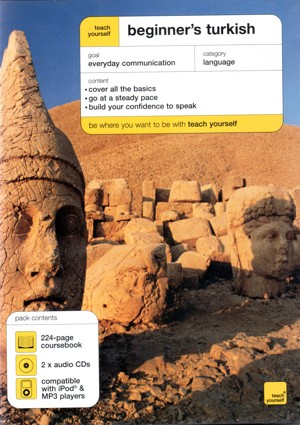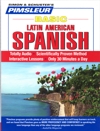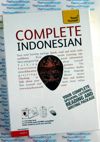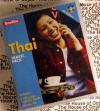Teach Yourself Beginners Turkish Book and 2 Audio CDs - Learn to Speak Turkish

Teach Yourself Beginners Turkish2 Audio CDs and Book |
 |
Teach Yourself Beginners Turkish - 2 Audio CDs BookIncludes 2 CDs and 224 page course-books Goal Content There are 16 carefully graded and interlocking units. Each unit introduces new language structures firmly embedded in a functional context, which means you concentrate on the uses to which you can put the language in everyday situations. There is also comprehensive help with the pronunciation both in the Introduction and on the accompanying 2 x 60-minute CD About the Authors
After teaching English as a Foreign Language in Switzerland, Bulgaria and Turkey, David Pollard, co-author, became a computer analyst-programmer and spent a decade developing educational software. He now works in medical education. About the Turkish LanguageTurkish is a language spoken by 65–73 million people worldwide, making it the most commonly spoken of the Turkic languages. Its speakers are located predominantly in Turkey, with smaller communities in Cyprus, Bulgaria, Greece, and Eastern Europe. Turkish is also spoken by several million immigrants in Western Europe, particularly in Germany. The roots of the language can be traced to Central Asia, with the first written records dating back nearly 1,200 years. To the west, the influence of Ottoman Turkish—the immediate precursor of today's Turkish—spread as the Ottoman Empire expanded. In 1928, as one of Atatürk's Reforms in the early years of the new Turkish Republic, the Ottoman script was replaced with a phonetic variant of the Latin alphabet. Concurrently, the newly founded Turkish Language Association initiated a drive to reform the language by removing Persian and Arabic loanwords in favor of native variants and coinages from Turkic roots. The distinctive characteristics of Turkish are vowel harmony and extensive agglutination. The basic word order of Turkish is Subject Object Verb. Turkish has a T-V distinction: second-person plural forms can be used for individuals as a sign of respect. Turkish also has no noun classes or grammatical gender. Turkic languages and Altaic languages Turkish is a member of the Turkish, or Western, subgroup of the Oghuz languages, which includes Gagauz and Azeri. The Oghuz languages form the Southwestern subgroup of the Turkic languages, a language family comprising some 30 living languages spoken across Eastern Europe, Central Asia. and Siberia. Some linguists believe the Turkic languages to be a part of a larger Altaic language family. About 40% of Turkic language speakers are Turkish speakers. The characteristic features of Turkish, such as vowel harmony, agglutination, and lack of grammatical gender, are universal within the Turkic family and the Altaic languages.There is a high degree of mutual intelligibility between Turkish and the other Oghuz languages, including Azeri, Turkmen, Qashqai, and Gagauz. History The earliest known Turkic inscriptions reside in modern Mongolia. The Bugut inscriptions written in the Sogdian alphabet during the First Göktürk Khanate are dated to the second half of the 6th century. The two monumental Orkhon inscriptions, erected in honour of the prince Kul Tigin and his brother Emperor Bilge Khan and dating back to some time between 732 and 735, constitute another important early record. After the discovery and excavation of these monuments and associated stone slabs by Russian archaeologists in the wider area surrounding the Orkhon Valley between 1889–93, it became established that the language on the inscriptions was the Old Turkic language written using the Orkhon script, which has also been referred to as "Turkic runes" or "runiform" due to an external similarity to the Germanic runic alphabets. With the Turkic expansion during Early Middle Ages (c. 6th–11th centuries), peoples speaking Turkic languages spread across Central Asia, covering a vast geographical region stretching from Siberia to Europe and the Mediterranean. The Seljuqs of the Oghuz Turks, in particular, brought their language, Oghuz Turkic—the direct ancestor of today's Turkish language—into Anatolia during the 11th century. Also during the 11th century, an early linguist of the Turkic languages, Kaşgarlı Mahmud from the Kara-Khanid Khanate, published the first comprehensive Turkic language dictionary and map of the geographical distribution of Turkic speakers in the Compendium of the Turkic Dialects (Ottoman Turkish: Divânü Lügati't-Türk). Ottoman Turkish Following the adoption of Islam c. 950 by the Kara-Khanid Khanate and the Seljuq Turks, who are regarded as the cultural ancestors of the Ottomans, the administrative language of these states acquired a large collection of loanwords from Arabic and Persian. Turkish literature during the Ottoman period, particularly Ottoman Divan poetry, was heavily influenced by Persian, including the adoption of poetic meters and a great quantity of borrowings. The literary and official language during the Ottoman Empire (c. 1299–1922) was a mixture of Turkish, Persian, and Arabic that differed considerably from the period's everyday spoken Turkish, and is termed Ottoman Turkish. Language reform and modern Turkish After the foundation of the Republic of Turkey and the script reform, the Turkish Language Association (TDK) was established in 1932 under the patronage of Mustafa Kemal Atatürk, with the aim of conducting research on Turkish. One of the tasks of the newly-established association was to initiate a language reform to replace loanwords of Arabic and Persian origin with Turkish equivalents. By banning the usage of loanwords in the press, the association succeeded in removing several hundred foreign words from the language. While most of the words introduced to the language by the TDK were newly derived from Turkic roots, it also opted for reviving Old Turkish words which had not been used for centuries. Due to this sudden change in the language, older and younger people in Turkey started to differ in their vocabularies. While the generations born before the 1940s tend to use the older terms of Arabic or Persian origin, the younger generations favor new expressions. It is particularly ironic that Atatürk himself, in his monumental speech to the new Parliament in 1927, used a style of Ottoman diction which today sounds so alien that it has had to be "translated" three times into modern Turkish: first in 1963, again in 1986, and most recently in 1995. There is also a political dimension to the language debate, with conservative groups tending to use more archaic words in the press or everyday language. The past few decades have seen the continuing work of the TDK to coin new Turkish words to express new concepts and technologies as they enter the language, mostly from English. Many of these new words, particularly information technology terms, have received widespread acceptance. However, the TDK is occasionally criticized for coining words which sound contrived and artificial. Some earlier changes—such as bölem to replace fırka, "political party"—also failed to meet with popular approval (in fact, fırka has been replaced by the French loanword parti). Some words restored from Old Turkic have taken on specialized meanings; for example betik (originally meaning "book") is now used to mean "script" in computer science. Many of the words derived by TDK coexist with their older counterparts. This usually happens when a loanword changes its original meaning. For instance, dert, derived from the Persian dard (درد "pain"), means "problem" or "trouble" in Turkish; whereas the native Turkish word ağrı is used for physical pain. Sometimes the loanword has a slightly different meaning from the native Turkish word, giving rise to a situation similar to the coexistence of Germanic and Romance words in English (see List of Germanic and Latinate equivalents). Among some of the old words that were replaced are terms in geometry, cardinal directions, some months' names, and many nouns and adjectives. |
Teach Yourself Beginners Turkish - 2 Audio CDs and Book |
| Stock Info: | Out of Print |

 0 Items (Empty)
0 Items (Empty)




